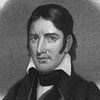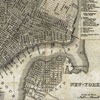Contrasts in American Life
The federal government encouraged this wave of westward migration by dropping the price of public land and reducing the minimum acreage that settlers had to purchase. In 1800, for example, the cheapest lands in the public domain sold for $2.00 an acre (the best lands sold at auction for much higher prices) with a minimum tract requirement of 320 acres. These policies favored land speculators who had the capital to buy large parcels of land. By 1820, Congress had reduced the price to $1.25 per acre and lowered the minimum acreage purchase to 40. Speculators and farmers gobbled up the cheap public acres at a staggering pace.
The frontier experience contrasted sharply from life in the eastern cities. For a sample of these diverging lifestyles, click the image of Davy Crockett to learn about bear hunting on the Tennessee frontier. Click the city image for a description of antebellum New York.

